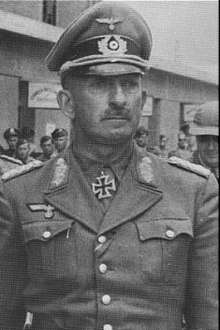Hans-Jürgen von Arnim
Hans-Jürgen von Arnim (German: [ˈaɐ̯niːm]; 4 April 1889 – 1 September 1962) was a German general in the Wehrmacht of Nazi Germany during World War II who commanded several armies. He was a recipient of the Knight's Cross of the Iron Cross.
Hans-Jürgen von Arnim | |
|---|---|
 | |
| Born | 1889 Ernsdorf, Province of Silesia, Kingdom of Prussia in the German Empire |
| Died | Bad Wildungen, West Germany |
| Allegiance |
|
| Service/ | Army (Wehrmacht) |
| Years of service | 1907–43 |
| Rank | |
| Battles/wars | World War I World War II |
| Awards | Knight's Cross of the Iron Cross |
World War II
Von Arnim joined the German Army in 1907 and took part in World War I. After the war, he remained in the Reichswehr and then the Wehrmacht. Arnim commanded the 52nd Infantry Division in both the Battles for Poland and France. In October 1940, Arnim was given command of the 17th Panzer Division.
Von Arnim took part in Operation Barbarossa, the invasion of the Soviet Union, and on 1 October 1941, took command of XXXIX Panzer Corps until November 1942.
On 20 February 1943 he was appointed commander of the 5th Panzer Army under Erwin Rommel in North Africa, whom he replaced as commander of the Army Group Africa on the 10th March 1943. He surrendered to British forces on 12 May 1943 as a consequence of the successful allied Operation Vulcan.[1]
His surrender to the British was a part of Spike Milligan's Monty: His Part in My Victory where his name has been misnamed (whether by accident or on purpose as Millgan eventually used to rename a lot of the characters within his Memoirs so that they or their relations would not be embarrassed by the activities) to Von Arnheim where Major Chater-Jack makes the announcement of the German defeat stating that "It's over! General Von Arnheim (sic) has surrendered and he is very angry."
Von Arnim was interned along with 24 other German general officers at Camp Clinton, Mississippi,[2] and was released on 1 July 1947.[3]
He died in 1962 in Bad Wildungen, West Germany.
Mistreatment of Jewish population of Tunisia
Under Arnim Jewish population of Tunisia was used for forced labour to prepare defences against Allied attacks and the Jewish community was also ruthlessly plundered for gold.[4]
Promotions
- Fahnenjunker-Gefreiter (25 May 1908)
- Fahnenjunker-Unteroffizier (18 July 1908)
- Fahnrich (19 November 1908)
- Leutnant (19 August 1909)
- Oberleutnant (27 January 1915)
- Hauptmann (27 January 1917)
- Major (1 April 1928)
- Oberstleutnant (1 April 1932)
- Oberst (1 July 1934)
- Generalmajor (1 January 1938)
- Generalleutnant (1 December 1939)
- General der Panzertruppe (17 December 1941)
- Generaloberst (4 December 1942)
Awards
- Iron Cross (1914) 2nd Class (16 September 1914) & 1st Class (2 November 1914)[5]
- Knight's Cross of the Royal House Order of Hohenzollern with Swords (7 September 1918)[5]
- Wound Badge in White (6 August 1918)[5]
- Honour Cross of the World War 1914/1918 (15 November 1934)[5]
- Wehrmacht Long Service Award 1st Class (2 October 1936)[5]
- Knight's Cross of the Iron Cross on 4 September 1941 as commander of the 17th Panzer Division[6]
References
Citations
- I Was There! - How Von Arnim Surrendered at Last, The War Illustrated, June 11, 1943.
- "German POW Camp in Clinton MS. Mostly Afrika Corps". kilroywashere.org.
- MacDonogh 2007, p. 410.
- General von Arnim had arrived to take over the forces in Tunisia, now designated the Fifth Panzer Army. Arnim prepared defences against renewed Allied attacks and Tunisian Jews were rounded up for forced labour. The Jewish community was also ruthlessly plundered for gold. The Second World War Antony Beevor, Little Brown and Company, New York 2012
- Wegmann 2004, p. 22.
- Scherzer 2007, p. 194.
Bibliography
- MacDonogh, Giles (2007). After the Reich. New York: Basic Books. ISBN 978-0-465-00337-2.CS1 maint: ref=harv (link)
- Scherzer, Veit (2007). Die Ritterkreuzträger 1939–1945 Die Inhaber des Ritterkreuzes des Eisernen Kreuzes 1939 von Heer, Luftwaffe, Kriegsmarine, Waffen-SS, Volkssturm sowie mit Deutschland verbündeter Streitkräfte nach den Unterlagen des Bundesarchives [The Knight's Cross Bearers 1939–1945 The Holders of the Knight's Cross of the Iron Cross 1939 by Army, Air Force, Navy, Waffen-SS, Volkssturm and Allied Forces with Germany According to the Documents of the Federal Archives] (in German). Jena, Germany: Scherzers Militaer-Verlag. ISBN 978-3-938845-17-2.CS1 maint: ref=harv (link)
- Wegmann, Günter (2004). Die Ritterkreuzträger der Deutschen Wehrmacht 1939–1945 Teil VIIIa: Panzertruppe Band 1: A–E [The Knight's Cross Bearers of the German Wehrmacht 1939–1945 Part VIIIa: Panzer Force Volume 1: A–E] (in German). Bissendorf, Germany: Biblio-Verlag. ISBN 978-3-7648-2322-1.CS1 maint: ref=harv (link)
| Military offices | ||
|---|---|---|
| Preceded by Generaloberst Karl-Adolf Hollidt |
Commander of 52. Infanterie-Division September 8, 1939 – October 5, 1940 |
Succeeded by Generaloberst Lothar Rendulic |
| Preceded by General der Panzertruppe Wilhelm Ritter von Thoma |
Commander of 17. Panzer-Division September 15, 1941 – November 11, 1941 |
Succeeded by Generalleutnant Rudolf-Eduard Licht |
| Preceded by Generaloberst Rudolf Schmidt |
Commander of XXXIX. Panzerkorps November 11, 1941 – November 30, 1942 |
Succeeded by General der Artillerie Robert Martinek |
| Preceded by created |
Commander of 5th Panzer Army December 8, 1943 - March 10, 1943 |
Succeeded by General der Panzertruppe Gustav von Vaerst |
| Preceded by Generalfeldmarschall Erwin Rommel |
Commander of Heeresgruppe Afrika March 10, 1943 – May 13, 1943 |
Succeeded by disbanded |